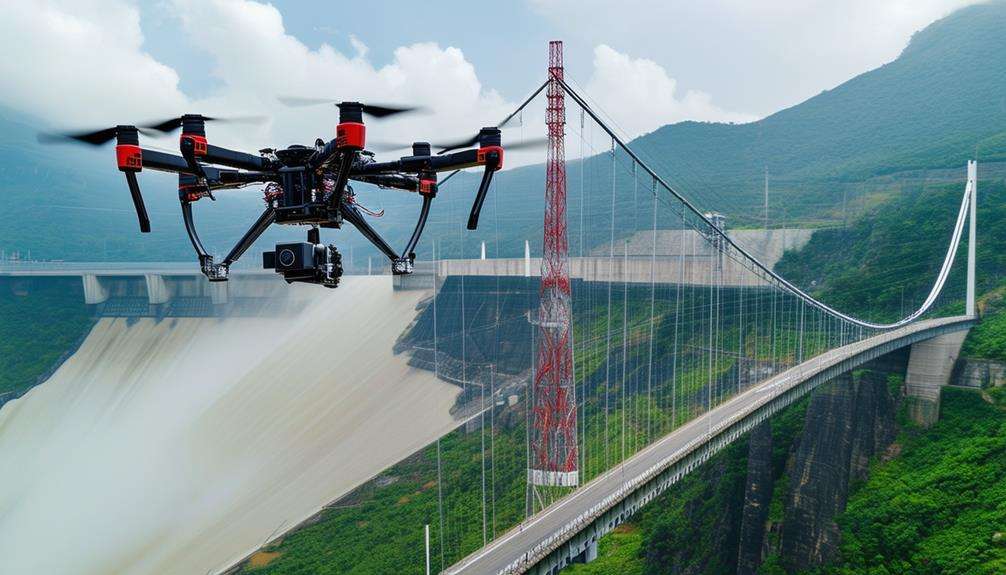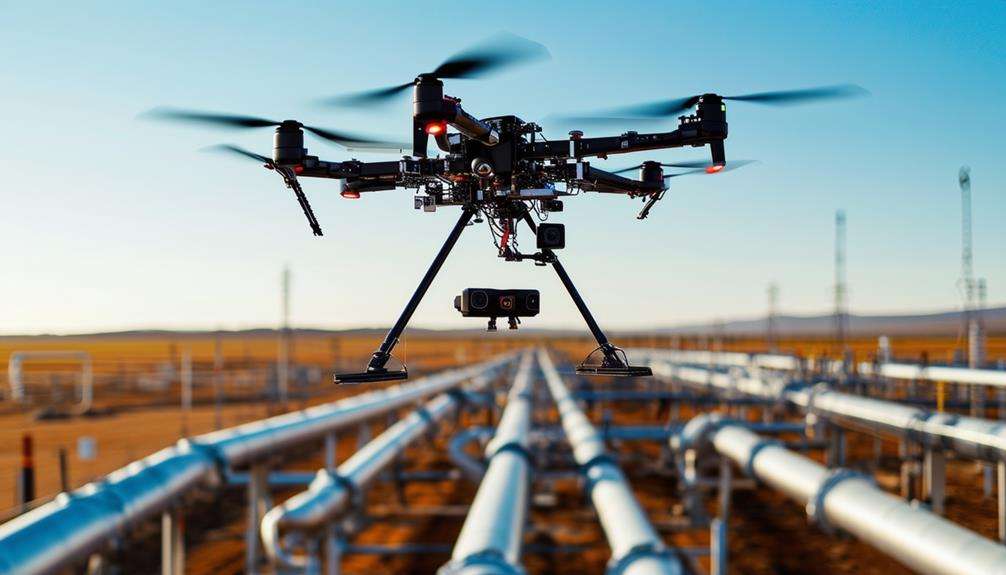The Cost of Implementing Drones in Your Business
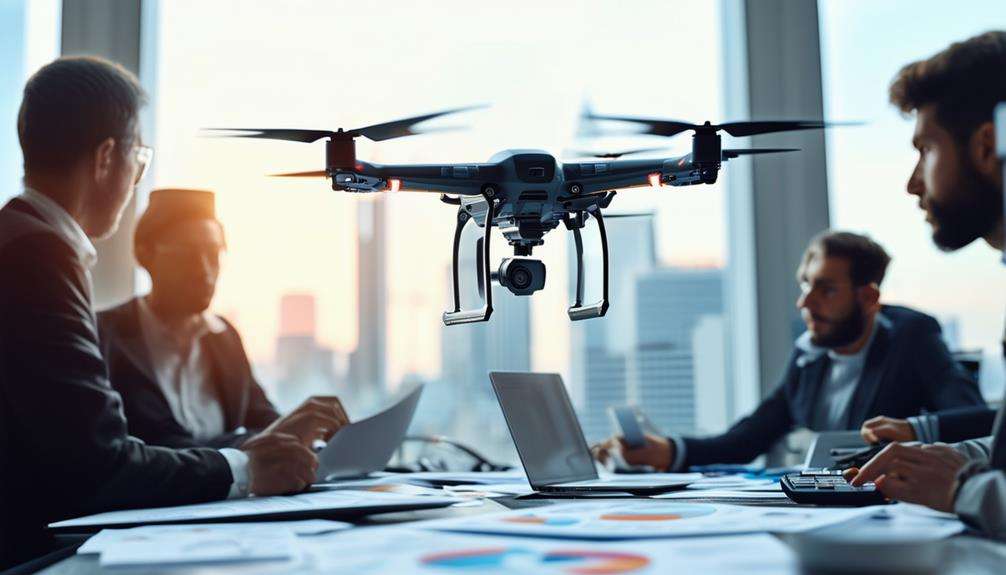
When considering the implementation of drones into your business, the initial investment is just the beginning. You'll need professional-grade drones, controllers, and safety gear. Additionally, training courses like the GVC and A2 Certificate of Competence are essential and come with their own costs.
Don't overlook software licenses, maintenance, repairs, and compliance fees, which can quickly accumulate. Proper budgeting for these expenses is crucial to ensure legal compliance and operational efficiency. Are you prepared for the full financial commitment required to integrate this technology into your operations?
Initial Investment
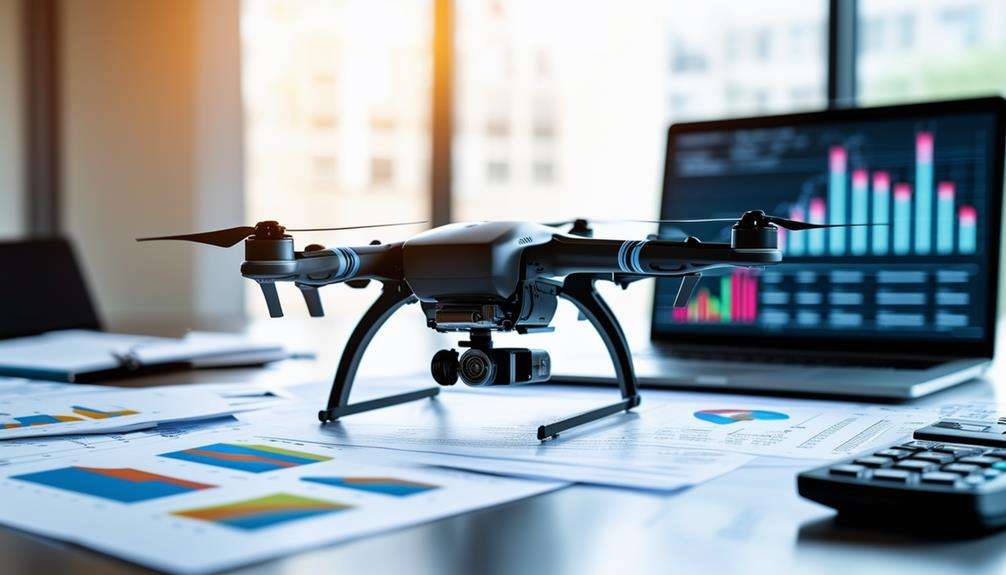
When incorporating drones into your business, it's essential to consider the initial investment costs. This includes the price of drones such as the DJI Mini 3 Flymore and DJI Matrice 350. The DJI Mini 3 Flymore is a budget-friendly option offering useful functionalities, while the DJI Matrice 350 is a high-end model designed for complex tasks, which entails a higher cost.
In addition to purchasing the drones, factor in training expenses. Proper training ensures your team can operate these drones safely and effectively. Essential courses include the General Visual Line of Sight (GVC) course, A2 Certificate of Competence courses, and PfCO to GVC conversion courses. These courses cover both operational and legal requirements, which are mandatory for commercial drone use.
Investing in training early on can save time and money by reducing the risk of accidents and ensuring regulatory compliance. While the initial investment may seem substantial, it's a necessary step for successfully integrating drones into your business operations.
Essential Equipment
After addressing the initial investment, let's explore the essential equipment you'll need to integrate drones into your business effectively.
Professional-Grade Drones
First and foremost, you'll need professional-grade drones. These can range from $1,000 to $5,000, depending on the model and features. High-quality drones are crucial for reliable performance and durability in various business operations.
Controllers and Monitors
Next, you'll need controllers and monitors to operate your drones efficiently. Controllers typically cost between $300 to $1,000, while monitors range from $200 to $800. These tools are essential for maintaining precise control and ensuring a clear view of the drone's operations, facilitating smooth task execution.
Batteries and Charging Systems
Batteries and charging systems are also vital. Individual batteries cost between $100 to $300, and you'll likely need several to ensure continuous operation. Charging systems can range from $100 to $500, providing the necessary power to keep your drones operational throughout the day.
Safety Gear and Maintenance Tools
Lastly, don't overlook safety gear and maintenance tools. Protective equipment and maintenance tools are essential for safe drone operations and can cost between $100 to $500. Investing in quality safety gear will protect both your equipment and personnel, enhancing the reliability and security of your drone operations.
Training Courses
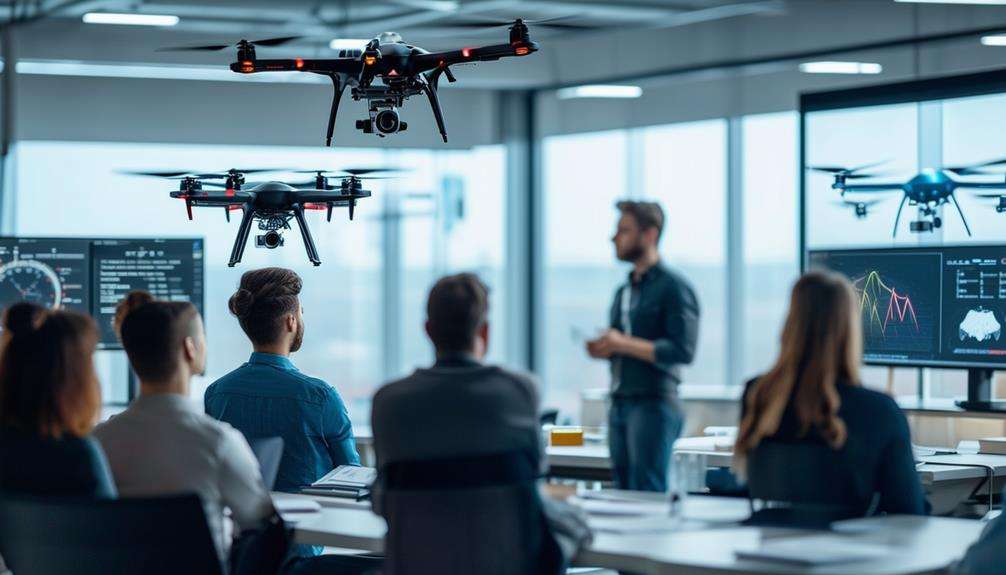
To successfully integrate drones into your business operations, it's essential to consider certification requirements, training duration, and course costs. Key certifications like the General Visual Line of Sight (GVC) and A2 Certificate of Competence are crucial for regulatory compliance and safety assurance. Investing in professional training ensures your team operates proficiently and within legal guidelines.
Certification Requirements
Getting certified to operate drones in your business involves completing specific training courses and obtaining necessary IDs. Certification is crucial for any aspiring drone operator to ensure safe and legal operations.
The General Visual Line of Sight (GVC) course, costing approximately £1195 plus VAT, is comprehensive and includes practical flying training, theory sessions, and an operations manual workshop to thoroughly prepare you.
Additional courses like the A2 Certificate of Competence address weight and proximity restrictions, while the PfCO to GVC Conversion Courses cater to those needing specialized training. These courses are often taught by experienced ex-military aviators, providing a robust learning environment.
Moreover, you'll need both a Flyer ID and an Operator ID for drones under 250 grams to comply with regulations. These IDs ensure adherence to legal requirements and safe drone operation.
Interactive, face-to-face training enhances your understanding and skills, offering continuous support for aspiring drone operators. By meeting these certification requirements, you not only comply with the law but also lay a solid foundation for successful drone operations within your business.
Training Time Commitment
Committing to drone training courses requires a substantial investment of time and effort to ensure you master both practical and theoretical aspects. The training involves comprehensive instruction that covers practical flying skills and in-depth theoretical knowledge. You'll dedicate considerable hours, especially if pursuing the General Visual Line of Sight (GVC) certification, which includes practical flying training, theory, and an operations manual workshop.
Interactive learning is a core component, providing hands-on experience and continuous support. Trainers, often with ex-military backgrounds and extensive drone expertise, offer face-to-face sessions that enhance your learning experience. This personalized approach equips you with the confidence and skills necessary to operate drones safely and efficiently.
Additional certifications, such as the A2 Certificate of Competence, may also be required based on your specific drone operations. These courses come with their own requirements and time commitments.
Cost of Courses
After understanding the time commitment required for drone training, it's crucial to consider the financial investment involved. When starting a drone business, budgeting for essential training programs is necessary. For example, the General Visual Line of Sight (GVC) course is a must-have, costing approximately £1,195 plus VAT. This course covers practical flying training, theory, and an operations manual workshop, all of which are essential for effective commercial drone operation.
However, the GVC course isn't the only expense. Additional certifications, such as the A2 Certificate of Competence and PfCO to GVC Conversion Courses, may also be required depending on your specific commercial drone operations. These additional courses can quickly add up, so it's important to incorporate them into your annual training budget. Moreover, regulatory compliance is mandatory, requiring both a Flyer ID and an Operator ID for drones weighing under 250 grams.
Many trainers are ex-military aviators with extensive experience, offering face-to-face training and ongoing support. Their interactive learning experiences ensure proficiency and adherence to legal standards, reinforcing the value of investing in quality training.
Insurance Coverage
Securing the right insurance coverage for your drone operations is crucial to protect your business from unforeseen incidents and potential liabilities. Commercial drone insurance can cover a wide range of risks, including liability and equipment damage. The annual cost for comprehensive coverage typically ranges between $500 and $2,000, an investment necessary for safeguarding your assets and ensuring business continuity.
When evaluating insurance options, consider the following factors that can influence cost and coverage:
- Coverage Limits: Higher limits offer more protection but come with increased premiums.
- Business Size: Larger operations may need more extensive coverage, affecting costs.
- Types of Operations: Specialized activities, such as aerial photography or surveying, may require tailored policies.
- Risk Exposure: Operating in high-risk areas or undertaking high-value projects can impact premium rates.
Understanding your specific needs is essential for choosing the right insurance provider. Many providers offer customized policies to address the unique risks faced by drone operators. Comprehensive insurance coverage not only ensures compliance with industry regulations but also provides peace of mind, allowing you to focus on expanding your business without worrying about potential setbacks.
Software Expenses
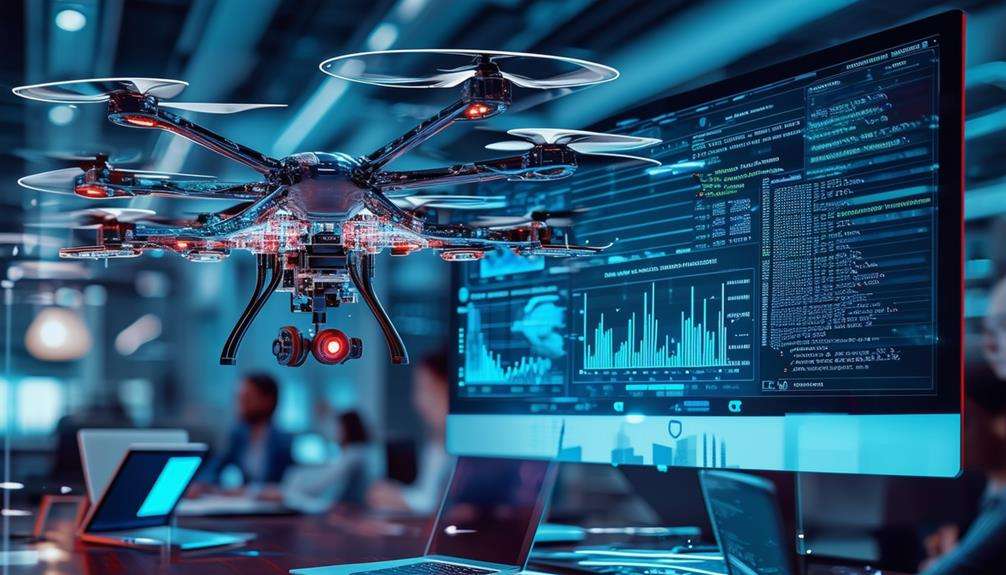
When implementing drones, it's crucial to consider the costs associated with software licenses and subscriptions, which can vary significantly. Customizing and integrating these software solutions with your existing systems may also increase your expenses. Accurately understanding these costs is essential for effective budgeting and ensuring seamless operations.
Licensing and Subscription Fees
Software expenses for drone operations can quickly add up. For example, programs like PIX4D cost approximately £260 per month, while a perpetual license might've a one-time fee of around £390. When integrating drones into your business, it's crucial to consider both licensing and subscription fees for the necessary software.
To ensure smooth drone operations, specialized software like DJI Terra Pro is often required, costing approximately £2,600 plus VAT for a perpetual license. These expenses are vital for tasks such as drone mapping and data analysis, but they aren't the only ones to consider.
Additional costs to anticipate include:
- GPS rover equipment: Essential for accurate data processing and mapping.
- Virtual Reference Station (VRS) licenses: Required for high-precision geospatial data.
- Data processing services: Can range from £250 to £350 per project depending on complexity.
- Commercial drone insurance and CAA applications: Necessary for legal and safe drone operations.
These costs can accumulate quickly, but they're essential for maintaining efficient and compliant drone operations. Make sure to budget for these licensing and subscription fees to avoid any unexpected financial strain.
Customization and Integration Costs
Effectively managing the customization and integration costs associated with drone software can be challenging. Initially, it's crucial to understand the full spectrum of expenses. Monthly subscriptions, such as PIX4D at $260, and perpetual licenses like DJI Terra Pro at $3,990, can quickly add up. To avoid surprises, list all potential costs, including specialized software for data processing and analysis, which can range from $500 to $3,500.
Integration costs are another significant consideration. High-end computers with specifications like Windows 10, Intel i9 processors, and SSD storage are essential for efficient data processing, ensuring you maximize the benefits of your drone software.
Customization expenses also play a vital role. Depending on your business needs, you may need to invest in specialized equipment such as GPS rovers and VRS licenses. Additionally, don't overlook the need for training and ongoing support to ensure seamless integration and functionality.
Cost Overview:
| Expense Type | Estimated Cost Range |
|---|---|
| Monthly Subscription | $260 (e.g., PIX4D) |
| Perpetual License | $3,990 (e.g., DJI Terra) |
| Data Processing Software | $500 - $3,500 |
| High-End Computers | Variable (custom specs) |
| Customization Tools | Variable (e.g., GPS rovers) |
Maintenance and Repairs
Keeping your drones in optimal condition involves regular maintenance and timely repairs. Annual maintenance costs typically range from $500 to $1,000, varying based on usage frequency and intensity. Regular maintenance tasks include battery replacements, software updates, and general inspections to ensure all systems are functioning properly. These preventative measures are crucial for avoiding major issues and maintaining peak drone performance.
Repair costs can range from $100 to $500 per incident, depending on the components involved. Common repair tasks may include fixing or replacing propellers, motors, and cameras. The costs fluctuate based on the damage's severity and whether professional servicing or just replacement parts are needed.
Key points to remember:
- Battery replacements: Essential for maintaining flight time and overall drone performance.
- Software updates: Keep your drone's firmware up-to-date to prevent operational issues.
- Component checks: Regularly inspect propellers and motors for signs of wear and tear.
- Professional servicing: Complex repairs are often best handled by experts.
Compliance Costs
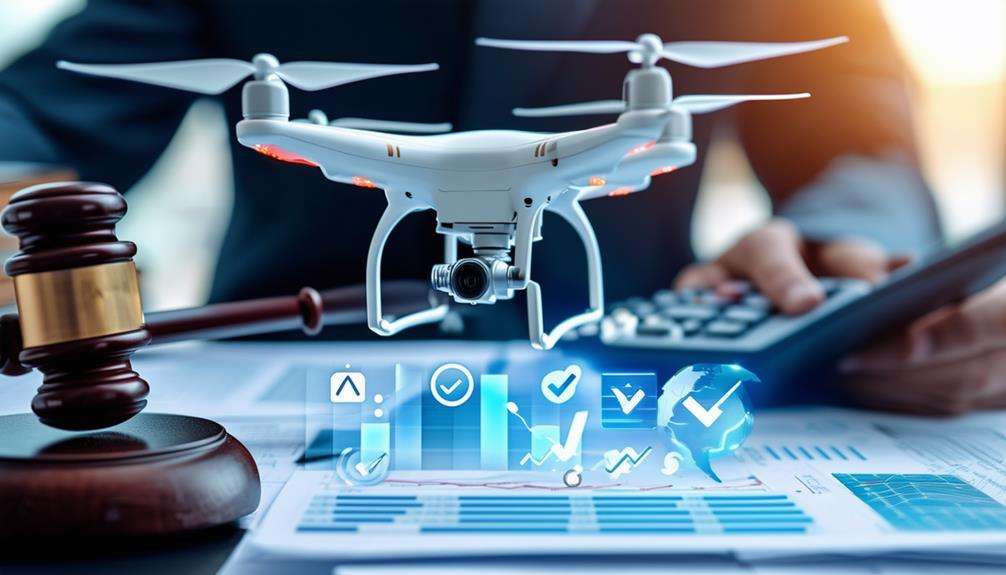
Managing compliance costs involves securing necessary certifications and adhering to legal requirements to ensure your drone operations stay within regulatory bounds. Depending on your location, you'll need to obtain certifications from the Federal Aviation Administration (FAA) or the Civil Aviation Authority (CAA). These certifications are essential for legal operation and must be renewed periodically, with renewal fees for CAA certifications typically ranging from £130 to £200 per year.
Legal compliance expenses extend beyond certifications. Conducting thorough risk assessments to identify potential hazards and mitigate risks associated with drone operations is critical for the safety of both your personnel and the public. Additionally, you must ensure your operations comply with data protection regulations, which involves implementing robust measures to safeguard any sensitive information collected during drone flights, thereby adhering to relevant data privacy laws.
Maintaining proper documentation is another critical aspect of compliance costs. Accurate documentation ensures your operations are transparent and traceable, which is vital for regulatory compliance.
Operational Costs
After addressing compliance costs, it's equally important to examine the various operational expenses associated with integrating drones into your business. Operational costs can quickly accumulate and impact your bottom line, making it essential to understand them comprehensively.
Firstly, consider the salaries of your drone pilots. Skilled pilots are crucial for safe and efficient operations, and their compensation represents a significant ongoing expense. Additionally, fuel or battery costs are another operational consideration. Whether your drones operate on gasoline or electricity, powering them incurs costs.
Next, factor in transportation and storage. You'll need to move drones to different locations and safely store them when not in use. These logistics expenses can add up over time. Regular maintenance, repairs, and upgrades are also critical ongoing costs. Drones must be kept in optimal condition to ensure smooth operation and compliance with regulations.
Key operational costs to consider:
- Drone pilot salaries
- Fuel or battery costs
- Transportation and storage expenses
- Maintenance, repairs, and upgrades
Evaluating these operational costs allows you to calculate the overall expenses and profitability of implementing drones in your business. Understanding these factors enables you to make informed decisions and optimize your operations effectively.
Conclusion
Integrating drones into your business is a significant investment that requires careful planning and budgeting. Essential expenses include equipment, training, insurance, software, and ongoing maintenance.
Compliance and operational costs are also critical to consider. By meticulously planning these aspects, you can ensure legal compliance, operational efficiency, and long-term profitability. Adopting drone technology can help your business reach new heights.


